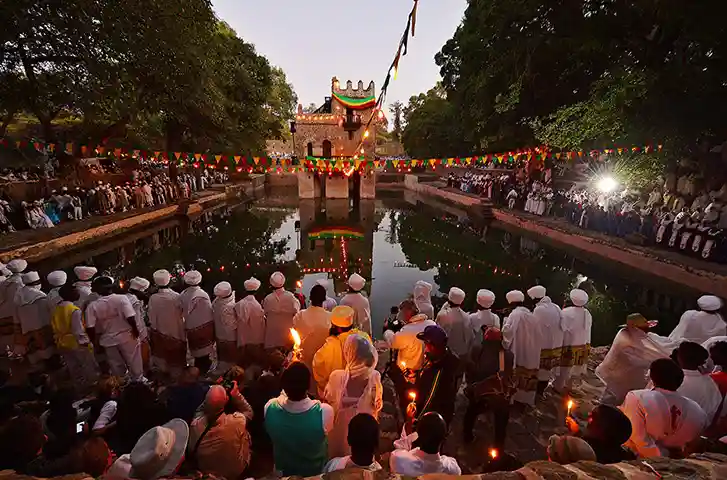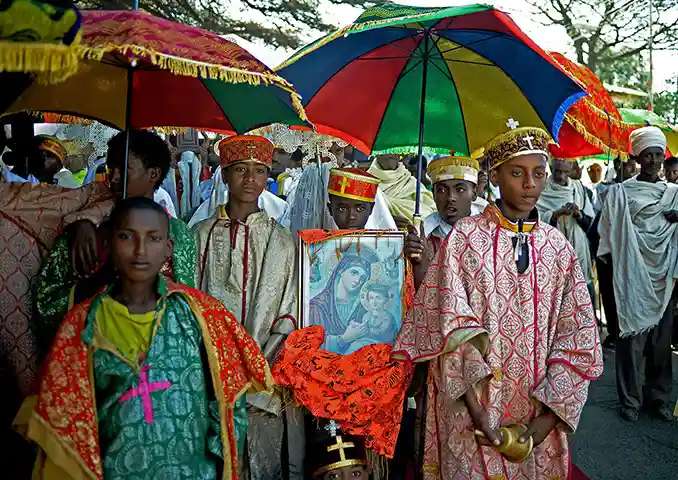1. Introduction to Timket: Ethiopia’s Sacred Celebration
Timket, also known as the Ethiopian Epiphany, is one of the most important and sacred celebrations in Ethiopia. This vibrant festival attracts thousands of locals and tourists from all over the world to witness the unique cultural and religious traditions that have been passed down through generations. From the baptism of Jesus in the Jordan River to volunteering and helping orphan children, Timket offers a one-of-a-kind experience. In this comprehensive guide, we will explore the rich history and significance of Timket, the best places to see the festivities, travel tips, and how you can immerse yourself in Ethiopian culture during this UNESCO-recognized intangible heritage celebration. Get ready to unlock the mysteries of Timket and embark on an unforgettable journey through Ethiopia’s most sacred celebration.
2. Understanding the Significance of Timket in Ethiopian Culture
Understanding the Significance of Timket in Ethiopian Culture
To truly appreciate the beauty and depth of the Timket celebration, it is important to understand its significance in Ethiopian culture. Timket, derived from the Amharic word “Timqat” meaning “baptism,” commemorates the baptism of Jesus by John the Baptist in the Jordan River.
For Ethiopians, Timket is not just a religious event; it is a time of renewal and spiritual awakening. It symbolizes the washing away of sins and the opportunity for redemption and rebirth. The faithful gather at rivers, ponds, or artificial pools early in the morning to reenact the baptism ritual, immersing themselves in the blessed waters.
Apart from its religious essence, Timket also serves as a unifying force for the Ethiopian community. It is a time when families come together, strengthening bonds and celebrating their shared heritage. The festival showcases the country’s cultural diversity, with each region adding its local touch to the festivities.
In the next section of this comprehensive guide, we will delve deeper into the rituals and ceremonies that make Timket a unique and cherished celebration in Ethiopian culture. Stay tuned to uncover more about the fascinating traditions that surround this revered event.
3. The Religious Rituals and Symbolism Behind Timket
The Timket celebration is rich in religious rituals and symbolism, which deeply resonate with Ethiopians and contribute to the uniqueness of this sacred event. One of the most integral parts of the Timket ceremony is the replica of the Ark of the Covenant, known as the Tabot, which is kept in every Ethiopian Orthodox Church. During Timket, the Tabot is carefully wrapped and carried on the heads of priests and escorted by a colorful procession to the nearby body of water.
This procession represents the journey from Jerusalem to the Jordan River, where Jesus was baptized. The Tabot is placed in a specially constructed tent beside the water, representing the presence of God’s grace. Musical instruments such as drums, flutes, and sistra accompany this solemn moment, enhancing the spiritual atmosphere.
Early in the morning, the priest blesses the water, recites prayers, and sprinkles the gathered faithful with holy water. This act symbolizes the purification and renewal of their souls, as well as their commitment to their faith. After the blessing, the faithful plunge into the water, fully immersing themselves to reenact Jesus’ baptism and cleanse themselves of their sins.
The entire ritual is shrouded in a profound sense of spirituality, creating a strong connection between the participants and their faith. The symbolism behind Timket serves as a reminder of the importance of repentance, forgiveness, and the opportunity for personal transformation.
In our next section, we will explore the vibrant festivities and cultural traditions that accompany the religious rituals of Timket. Stay tuned to uncover the lively celebrations that make this event an extraordinary experience.
4. An In-Depth Look at the Traditional Ceremonies and Processions
An In-Depth Look at the Traditional Ceremonies and Processions
In addition to the religious rituals and symbolism, Timket is also a time of vibrant celebrations and cultural traditions. Ethiopian communities come together to honor this sacred event in various ways, ensuring that every moment of Timket is filled with excitement and joy.
One of the most prominent features of Timket is the enchanting procession that accompanies the Tabot. Thousands of people gather to witness the grandeur of this event as priests, adorned in their traditional robes, carry the Tabot on their heads. The procession is a visual spectacle, with colorful umbrellas and beautifully embroidered cloths adding to the elegance of the moment.
Alongside the priests, the faithful join in the procession, carrying lit candles and singing hymns of praise. Drummers and musicians further enliven the atmosphere with their rhythmic beats and melodies, captivating both participants and onlookers alike.
The procession weaves through the streets, following a carefully planned route that highlights the historical and cultural significance of each location. As the Tabot makes its way towards the designated body of water, the energy and enthusiasm of the crowd reach a crescendo.
Once the procession reaches its destination, a sense of anticipation fills the air. The Tabot is placed in a specially constructed tent, adorned with colorful fabrics and flowers. This moment represents the culmination of the journey from Jerusalem to the Jordan River, creating a palpable connection to the biblical story of Jesus’ baptism.
As the ceremonies proceed, the priests perform sacred rites and recite blessings, enveloping the crowd in a spiritual aura. The faithful listen intently, absorbing every word and praying for their own spiritual renewal.
Timket is not just a religious event; it is a celebration of community, heritage, and faith. The ceremonies and processions give everyone the opportunity to come together, reaffirm their beliefs, and rejoice in the shared culture that has been passed down through generations.
Stay tuned for the next section where we delve into the traditional dances, mouth-watering feasts, and joyful festivities that make Timket a truly unforgettable experience.
5. Exploring the Vibrant Festivities and Cultural Traditions During Timket
Next section:
Once the diligent religious ceremonies of Timket have concluded, the festivities continue with an explosion of color, music, and dance. This is a time when Ethiopian communities showcase their rich cultural heritage, inviting locals and tourists alike to immerse themselves in the joyous celebrations.
One of the most captivating aspects of Timket is the traditional dances that take place during the festivities. Vibrant costumes, rhythmic movements, and intricate choreography bring the stories and legends of Ethiopia to life. From the famous Eskista dance with its graceful shoulder and hip movements to the energetic Guragigna, every dance captures the essence of Ethiopian culture and leaves an indelible impression on the audience.
Food is also an integral part of Timket, as communities gather to indulge in mouth-watering feasts that tantalize the taste buds. Traditional dishes such as Doro Wat, a spicy chicken dish, and Injera, a sourdough flatbread, are prepared with love and shared amongst friends and family. The aroma of spices and the sound of laughter fill the air, creating an atmosphere of warmth and conviviality.
The festivities during Timket are not confined to daytime celebrations only. Nighttime brings its own charm, with bonfires and lanterns lighting up the darkness. This magical ambiance sets the stage for singing and storytelling, where tales from Ethiopia’s rich folklore are passed down through generations.
As the festivities continue, visitors have the opportunity to engage with local artisans and witness traditional craftsmanship firsthand. Stallholders display their intricately woven textiles, beautifully carved wooden artifacts, and exquisite jewelry, showcasing the talent and skill of Ethiopian artisans.
The spirit of unity and togetherness is palpable during Timket, as people from all walks of life come together to celebrate their shared culture and faith. It is a time where strangers become friends and laughter knows no bounds.
In the next section, we will explore the significance of the ritual bath during Timket and its profound spiritual meaning. Join us as we dive deep into the transformative experience of renewal that lies at the heart of this sacred celebration.
6. Tips and Recommendations for Attending Timket Safely and Respectfully
As you prepare to attend Timket, it’s important to remember that this sacred celebration holds deep meaning for the Ethiopian people. To ensure you have a safe and respectful experience, here are some tips and recommendations to consider:
1. Dress Appropriately: As Timket is a religious event, modest attire is highly encouraged. Both men and women should cover their shoulders and legs when entering places of worship. Additionally, it’s a good idea to wear comfortable shoes, as you may be standing or walking for long periods.
2. Respect the Rituals: During the ritual bath, do not interfere or participate unless invited to do so by a local. This is a solemn and sacred practice that should be observed with reverence. Keep in mind that photography might be restricted during certain parts of the ceremony, so it’s best to ask for permission before taking pictures.
3. Be Mindful of Personal Belongings: While Timket is generally a safe event, it’s always wise to take precautions. Avoid carrying unnecessary valuables and keep your belongings secure at all times. It’s also a good idea to have copies of important documents, such as your passport, in case of emergencies.
4. Follow Local Customs and Etiquette: Familiarize yourself with Ethiopian customs and practices before attending Timket. This includes greeting others with respect, refraining from pointing with your fingers, and asking for permission before taking photos of individuals.
5. Stay Hydrated and Protected: Timket usually takes place during the dry season, so the sun can be intense. Drink plenty of water and wear sunscreen to protect yourself from sunburn. Consider carrying a hat and sunglasses to provide additional protection.
6. Embrace Cultural Exchange: Timket is a unique opportunity to immerse yourself in Ethiopian culture. Engage with locals, ask questions, and be open to learning about their traditions. Respect and appreciation for their customs will enrich your experience and foster meaningful connections.
By following these tips, you’ll be able to attend Timket safely and respectfully. Remember, the purpose of your visit is to honor and celebrate Ethiopian culture, so approach this event with humility and an open heart.
In the next section, we will delve deeper into the spiritual significance of the ritual bath, exploring the transformative power it holds for those who participate. Join us as we unravel the mysteries and divine connections that are woven into the fabric of Timket.
7. Preserving the Heritage: The Importance of Timket for Ethiopia’s Identity
Preserving the Heritage: The Importance of Timket for Ethiopia’s Identity
Timket is more than just a religious celebration; it is a cornerstone of Ethiopian culture and identity. Embedded in the fabric of the nation’s history, this sacred event holds immense significance for the Ethiopian people.
Timket, also known as the Epiphany, marks the baptism of Jesus Christ in the Jordan River. It is a time of profound spiritual awakening and renewal. As the faithful gather in droves to participate in the ritual bath, they seek purification of the soul and a reaffirmation of their faith.
This celebration not only serves as a spiritual reawakening but also reinforces Ethiopia’s historical and cultural heritage. Timket fosters a sense of unity and solidarity among Ethiopians, as people from all walks of life come together to share in this profound experience.
The importance of Timket extends beyond its religious connotations. It is a testament to Ethiopia’s resilience and strength, reflecting its ability to preserve ancient traditions despite the challenges faced throughout history. By celebrating Timket, Ethiopians honor their ancestors and ensure that their rich cultural legacy endures for generations to come.
Join us in the next section as we explore the symbolism and rituals of Timket, delving deep into the spiritual significance of this treasured celebration. Together, let us unlock the mysteries and marvel at the profound connections that Timket holds within its sacred rituals.
8. Conclusion: Embracing the Richness of Timket and Ethiopian Culture
Conclusion: Embracing the Richness of Timket and Ethiopian Culture
Timket is not just a religious celebration; it is an embodiment of Ethiopia’s rich cultural heritage and identity. From its historical roots to the spiritual awakening it provides, Timket is a testament to the resilience of the Ethiopian people.
By participating in this sacred event, Ethiopians not only reaffirm their faith but also come together in unity and solidarity. Timket serves as a powerful reminder of Ethiopia’s ability to preserve its traditions and honor its ancestors.
As we have explored the symbolism and rituals of Timket, we have witnessed the profound connections it holds within its sacred practices. By embracing the richness of Timket and Ethiopian culture, we can gain a deeper understanding and appreciation for the spiritual significance of this treasured celebration.
In the following sections, we will delve into the specific rituals and customs that make Timket such a unique and captivating event. Join us as we unravel the mysteries and immerse ourselves in the vibrant tapestry of Ethiopian culture.



